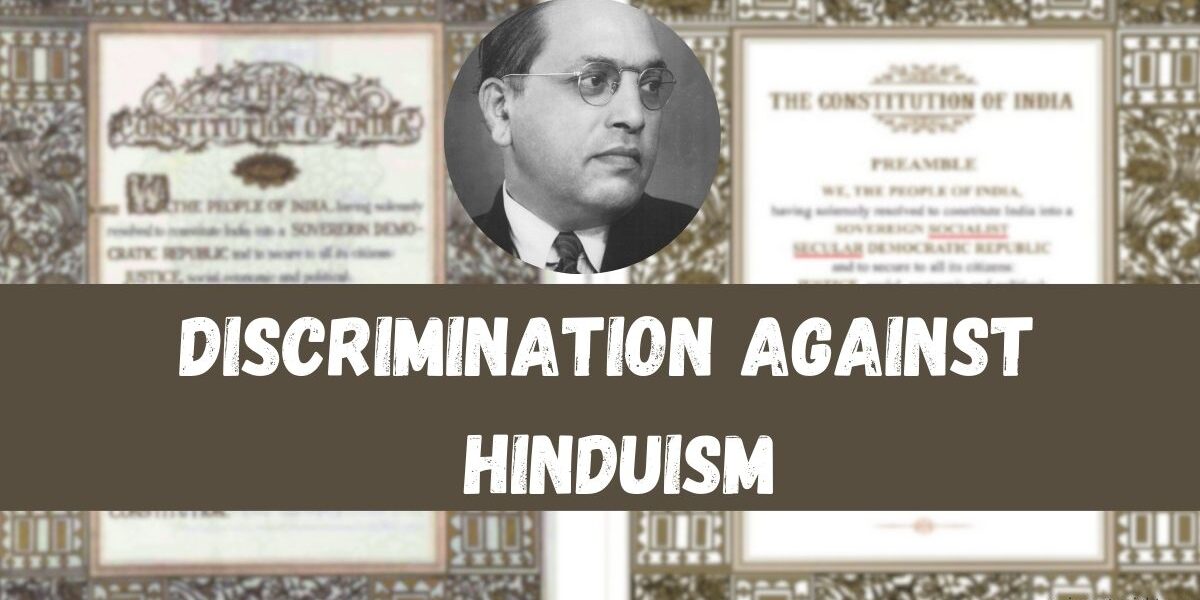
Constitutional Discrimination against Hinduism
In India, a secular country by its constitution, religious equality is a fundamental right. However, a closer examination reveals that certain laws and policies disproportionately affect the Hindu community, leading to claims of constitutional discrimination. This article highlights some of these laws and their discriminatory implications on Hinduism.
Before we proceed to the discriminatory laws. Let’s first understand Secularism.
What is Secularism
Secularism refers to the principle of separating religion from the government. This means that the government should treat all religions equally and cannot favor any particular religion. A secular government should remain neutral in religion, treating all religions and belief systems equally.
Secularism ensures that religious beliefs do not interfere with public affairs, governance, or law-making. It promotes freedom of religion and prevents any particular religion from dominating the government or public policy.
Indira Gandhi inserted the word secular in our preamble during the Emergency in 19761.
Now that we understand secularism. Let’s study some of the laws that discriminate against the Hindu community, thereby breaking the myth that India is a secular country.

State Control of Hindu Temples
Unlike other religious institutions in India, Hindu temples are under state control. Various state governments manage the finances and administration of these temples, often through specific legislations like the Hindu Religious and Charitable Endowments (HR&CE) Act2. This control affects the autonomy of Hindu religious practices and the utilization of temple resources.
This impacts the temples in multiple ways:
- Financial Control: Temple revenue is often redirected for secular purposes, limiting funds for temple maintenance and religious activities.
- Administrative Interference: Government-appointed administrators may not always respect traditional practices and rituals, disrupting religious observances.
According to activist T.R. Ramesh, the Tamil Nadu state government controls 2.44 crore square feet of temple land. The government should be earning a minimum of 6000 crores per annum from this land, but it earns merely 58 crores3.
Mahakaleshwar Mandir Act, 1982—This act was enacted by the Madhya Pradesh government to ensure the proper administration of the temple4.
The Waqf Act, 1995
The Waqf Act5 provides for the establishment of Waqf Boards to manage and oversee the properties donated for Islamic religious or charitable purposes. These boards operate with considerable autonomy, and their decisions are generally free from state intervention.

In essence, the Waqf properties are managed by Muslims, for Muslims, with minimal government interference.
Its impact are as follows:
- Legal Protection: Waqf properties have dedicated legal frameworks to protect them, whereas Hindu religious properties do not enjoy similar safeguards.
- Resource Allocation: Hindu institutions lack the structured administrative support that Waqf Boards provide to Islamic properties.
Their motto (as mentioned on their website) is “Once a Waqf, Always a Waqf.” Some of the draconian sections of the Waqf Act and their powers are as follows.
- Section 40 — Decide if any piece of land is Waqf or not.
- Section 54 — Declare anybody as an encroacher.
- Section 85 —Disputes related to waqf properties cannot be resolved in civil, revenue, or any other regular court. A designated Waqf Tribunal must exclusively handle them.
The Waqf is India’s third-largest landowner, after Defense and Railways. Even 77 percent of Delhi is on Waqf land, which includes some famous buildings such as the Delhi High Court, Central Vistas, CGO Complex, Jawaharlal Nehru Stadium, etc6.
The Right to Education (RTE) Act
The RTE Act7 mandates that Hindu-run institutions reserve 25% of their seats for economically weaker sections and disadvantaged groups. Minority institutions, however, are exempt from this requirement. This exemption puts Hindu institutions at a competitive disadvantage and places additional financial burdens on them as fee reimbursement is not provided on time by the government.

Its impact is as follows:
- Financial Strain: Unlike minority institutions, Hindu educational institutions bear the cost of reserving seats without equivalent support. Due to this, institutions are forced to hike fees to cover the financial burden. This hike in fees has forced parents to change the school of their children, ultimately leading to school shutdowns.
- Educational Equality: The exemption for minority institutions creates an unequal playing field, affecting the sustainability of Hindu-run schools.
Places of Worship Act, 1991
The Places of Worship (Special Provisions) Act, 19918, prohibits the conversion of any place of worship and mandates that the religious character of a place of worship as it existed on August 15, 1947, shall be maintained. This law affects the restitution of Hindu temples that were destroyed or converted before this date, preventing Hindus from reclaiming their religious heritage.
Its impact is as follows:
- Restitution Barred: Hindu temples that were demolished or converted to other religious sites before 1947 cannot be reclaimed, preserving historical injustices.
- Religious Rights: The Act restricts the ability of Hindus to restore and practice their faith at traditional sites.
Conclusion
These examples highlight how certain laws and policies have disproportionately impacted the Hindu community in India. Addressing these issues is crucial for ensuring true secularism and religious equality in the country. By recognizing and rectifying these imbalances, India can move closer to upholding the constitutional promise of equal treatment for all religions.
Thanks to Dr. Anand Ranganathan for writing such an awesome book, “Hindus in Hindu Rasthra.” It’s an eye-opening account of constitutional discrimination against Hindus. This article would not be completed without this book.




1 COMMENTS